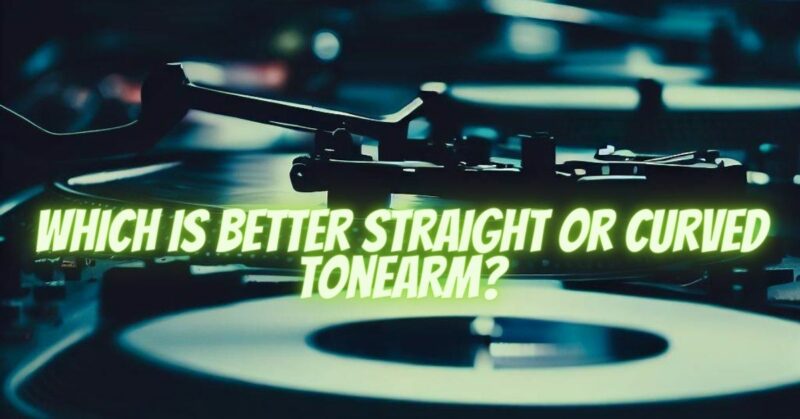When it comes to turntables, the tonearm plays a critical role in tracking the grooves of vinyl records, translating the physical movements into beautiful sound. One decision you’ll face when selecting a turntable is whether to opt for a straight or curved tonearm design. Both have their advantages and considerations, so let’s delve into the differences between straight and curved tonearms to help you make an informed decision.
There are two main types of tonearms: straight and curved. Straight tonearms are the most common type, and they are typically made of aluminum or carbon fiber. Curved tonearms are less common, but they are becoming increasingly popular.
So, which type of tonearm is better? There is no easy answer, as both straight and curved tonearms have their own advantages and disadvantages.
Straight Tonearms
Straight tonearms are the traditional design. They are typically made of metal, such as aluminum or carbon fiber, and they are relatively simple in construction. Straight tonearms are often seen as being more accurate than curved tonearms, as they are less likely to introduce tracking errors.
However, straight tonearms can also be more susceptible to resonance, which can cause unwanted vibrations and sound distortion. Additionally, straight tonearms can be more difficult to balance, which can also lead to tracking errors.
Curved Tonearms
Curved tonearms are a more recent development. They are typically made of metal or plastic, and they are often curved in an S- or J-shape. Curved tonearms are designed to reduce resonance and tracking errors. They are also easier to balance than straight tonearms.
However, curved tonearms can be more expensive than straight tonearms, and they can also be more difficult to find. Additionally, some people believe that curved tonearms can introduce a slight “veil” over the sound, which can reduce clarity.
Comparison Table
| Feature | Straight Tonearm | Curved Tonearm |
|---|---|---|
| Accuracy | More accurate | Less accurate |
| Resonance | More susceptible | Less susceptible |
| Tracking errors | More prone | Less prone |
| Balance | More difficult | Easier |
| Price | Less expensive | More expensive |
| Availability | More common | Less common |
| Sound quality | Some say clearer, others say veiled | Some say warmer, others say brighter |
Which is Better?
So, which is better, a straight or curved tonearm? There is no easy answer, as it depends on your individual preferences and priorities. If you are looking for the most accurate tonearm, then a straight tonearm is the way to go. However, if you are concerned about resonance and tracking errors, then a curved tonearm may be a better choice.
Ultimately, the best way to decide is to listen to both types of tonearms and see which one you prefer. If you have the opportunity, try listening to a turntable with both a straight and curved tonearm, using the same cartridge and record. This will give you a good idea of the differences in sound quality and tracking performance.
Conclusion
Whether you choose a straight or curved tonearm, the most important thing is to make sure that it is well-made and properly aligned. A poorly-made or poorly-aligned tonearm can have a negative impact on sound quality, regardless of its shape.When choosing between a straight and curved tonearm for your turntable, consider factors such as tracking accuracy, minimal tracking error, ease of cartridge alignment, improved inner groove performance, and cartridge compatibility. Straight tonearms excel in tracking accuracy and ease of setup, while curved tonearms compensate for the inward angle of the grooves and offer compatibility with a wider range of cartridges. Ultimately, the choice depends on your personal preferences, the type of records you listen to, and the specific characteristics you value in your vinyl playback experience.

